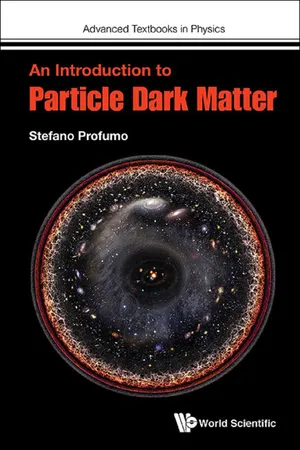![]()
Chapter 1
Particle Dark Matter: The Name of the Game
1.1Praeludium
In a letter to Sommerfeld dated December 9, 1915, Albert Einstein stated: “How helpful to us is Astronomy’s pedantic accuracy, which I used to ridicule!” (my emphasis).a He was referring to measurements of the advance of the perihelion of Mercury, one of the key observations testing predictions of General Relativity. The discovery of dark matter is a history of pedantic astronomical observations, leading to one coherent picture of a pre-posterous universe. One where only one fifth of the matter content is made of particles we know of, the rest being something we fundamentally know very little about: dark matter. And I am convinced that it will be thanks to the same, persistent pedantic accuracy of astronomers and particle physics experimentalists that we will eventually write the chapter of the book of physics about the nature of dark matter.
Thus far, we have been able to learn what the dark matter, as a particle, is not, by cleverly looking for its possible microscopic manifestations. However, we do know a fair amount about dark matter at a macroscopic level, and how such macroscopic features are connected with particle properties of the dark matter. We know very accurately how much dark matter is out there, globally, in the universe, and how the dark matter is distributed in selected regions of the universe; we quantitatively know that, besides gravity, dark matter interacts weakly, if at all, with the particles (of the Standard Model (SM) of particle physics) we know and love; we know that dark matter is cold, or at best warm (in a sense to be made clear later on); finally, we know that dark matter has been out there for a long while and still is — this implies that, as a particle, the dark matter must be stable, or very long lived.
Learning how we convinced ourselves that dark matter is indeed filling up the universe is a great way to learn facts that can be used to build particle models for the dark matter. This is the raison d’être for this chapter, besides perhaps giving you some ammunitions to explain what you do for a living to the inevitable chatty guy sitting next to you on a plane.
1.2There is more matter than the matter that shines — classical (mechanical) evidences
Many good reviews exist on evidences for dark matter (for a historical perspective see e.g. the recent book [1]). As I explained in the Preface, this book is not a review. Rather, here I choose to present a few select stories that feature interesting pieces of physics and that contain “life lessons” about dark matter as a particle.
Zwicky and the virial theorem
When you attend a seminar on dark matter, chances are the speaker will produce a one-liner about Zwicky’s 1930s “discovery” of dark matter in the Coma cluster, possibly accompanied by a funny picture of Zwicky doing the OK sign and a weird face (Fig. 1.1). If the Reader contents herself with that one-liner and funny picture, she should feel free to skip to the next section. If not, here is a somewhat quantitive account of what Zwicky actually did and said.
Figure 1.1: The funny guy who, some say, invented the name “dark matter”.
I think it is important to dig into Zwicky’s original arguments first because of history (a history that not many know well); second because classical mechanics is really beautiful, and Zwicky’s paper features a few little gems; and third because, as anything good in physics, Zwicky’s are simple arguments that only require you to know one equation: F = ma.
The logic that led Fritz Zwicky to his visionary statement that “should this turn out to be true, the surprising result would follow that dark matter is present in a much higher density than radiating matter” [2] is simple: the virial theorem applied to the motion of galaxies (or “nebulae” as they were called back then — it had not been long since people had figured out that they were extragalactic objects and not clouds (nebulae, in Latin) of gas or dust in the galaxy) in a galaxy cluster (specifically, Coma).
Let’s consider a “nebula”
i at position
i and of mass
Mi, and take the scalar product of “
F =
ma” with
i:
Now let us sum Eq. (1.1) over i, i.e. over all “nebulae” in the cluster, and get
where
is the polar moment of inertia,
is the “virial” of the cluster, and KT is the total nebulae kinetic energy. If the cluster is stationary, the polar moment of inertia fluctuates around a constant value, so the time average (which we will indicate with a bar) of its time derivative vanishes.b As a result, we get the virial theorem:
Zwicky continues, rather prophetically, stating that “On the assumptionc that Newton’s inverse square law accurately describes the gravitational interactions among nebulaed”, one gets
with
GN Newton’s gravitational constant, and
Exercise 1. Prove Eq. (1.2); it might be helpful to use the fact that
for a forc...











